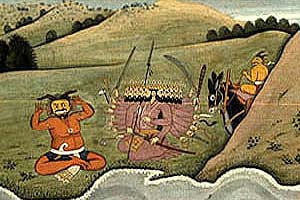| The Realm of Kings | The Temple and Sacred Text | Krishna | Rama | Devi | Shiva | Saints and Sadhus | The Realm of Gods | |||||||||||
|
The Realm of Gods Throughout India, the divine may be venerated in simple roadside shrines as often as in the huge temple complexes that have developed over the past two thousand years. Much of premodern Indian art—sculptures created for temple walls or home shrines, paintings produced for ruling classes, or folk images created by villagers—focuses on the plethora of gods and goddesses representing major theistic cults and devotional practices that have evolved in the subcontinent. From the fifteenth through the nineteenth century, the most popular deities were Krishna and Rama, two incarnations of the Hindu god Vishnu. In some regions, the Great Goddess (Devi) was also actively worshiped. Most of the paintings seen in this section of the exhibition were part of illustrated sets, depicting grand narratives or particular themes. Nineteenth-century photographs of temple-related subjects and select works of the Buddhist and Jain traditions provide a larger context for the religious diversity of India. |

Ravana converses with a demon by the sea, Detail
Illustration to a dispersed Ramayana series Kangra, Punjab Hills; ca. 1780 Opaque watercolor on paper Metropolitan Museum of Art, New York, Gift of Cynthia Hazen Polsky (MMA-1985.398.14) |